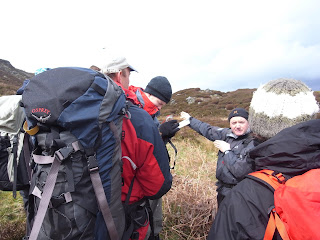
Intense. Plus a lot of fun with a bunch of like-minded people. That's the best way to describe a Mountain Leader (ML) training week with Stuart Johnston Mountaineering. Irene, Sarah, Ian, Gary, James and I were hit with an insane amount of exciting new info, so here's some scary micro navigation to kick off with.
I was in for a bit of a shock here! Before ML training I thought my navigation was pretty ok. However, MLs are expected to know where they are right down to 50m on a 1:50,000 scale map, and then a teeny tiny 25m on a 1:25,000 map.
Stuart had us looking at contour lines more minute detail than I ever had before. I was used to noticing whether the path I'd be following would be going up or down, but MLs have to look for spurs, re-entrants, knolls, flat spaces, steep and gentle slopes. It's more like orienteering.
Added to this zoomed-in look at the world MLs also have to be very aware of their timing, pacing and direction so as to ensure you hit the right spot. It's very much like learning to drive.
At first its you're surrounded by a mass of things to do and caught up in the order or doing them before you can even look out of the front window. Then hopefully, with a great deal of careful practice, you're ready to drive without even thinking, avoiding all the obstacles and even chatting away to the others in the car.
To improve your micro nav for your ML, try these:
Find out your 100m pace
Use a rope to measure out 100m of flat ground. Walk along it at your regular walking speed and count the number of double paces you take. MLs will have more 100m pace measurement numbers, for gentle and steep uphill and downhill slopes. Start with flat ground, then increase your pacing measurements to include up and downhills too.
Find out your walking speed and timing for 1km
Walking at 1km takes you 12 mins if you walk at 5km/hour. This is quite quick, and most people walk at 4km/hour or even 3 or 2km/hour if you are carrying a heavy backpack, the terrain is tricky, or you are going at the pace of a slower group member. Test how fast you generally walk over 1km on a flat section, then experiment with different gradients and loads. When walking with groups, use the first 10-30mins to time the group's average pace so you can plan the rest of the route accordingly.
Perfect timing
Get a stopwatch! MLs are expected to know how their timing and pacing works together to within the minute, so its useful to use a stopwatch to time navigation legs. Remember to start and stop it whenever you stop to check the map, have a break or stop for a chat.
Estimate distance
Look across at a distinct, mapped landmark like a house or pylon and try to estimate how far away it is without measuring the distance on your map. You might be surprised at your answers. This is a great help for increasing your navigation accuracy on clear days.
Next blog coming soon, where we find out that there's much more to being an ML than getting people from A-B...

Many thanks to National Rail who enabled me to travel to Scotland for my ML training. I travelled from Peterborough to Pitlochry by rail with National Express East Coast: advance returns, booked online, start from £36 Standard Class or £103 First Class: book via www.nationalexpresseastcoast.com, call 08457 225225 or visit any staffed station.
ReplyDelete